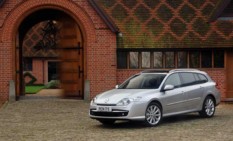Review
Isn’t it funny how fashions and opinions change over time?
When I was young, estate cars were the preserve of mums and the unfashionable.
They were boxy transporters, a sign that style and driving enjoyment came way down the priority list, behind space for pushchairs and drool-proof seats.
How things have changed.
I reckon that a significant proportion of recently-launched cars look best in estate form. Ford’s new Mondeo, Citroën’s forthcoming new C5 and now Renault’s Laguna Sport Tourer are all in their visual prime when sporting a cavernous boot.
According to Renault, I’m not alone – its research suggests that the hip young things are the ones going for estates.
It thinks buyers of the Sport Tourer are likely to be younger than those going for the Laguna hatch, and the estate is expected to make up between 40% and 50% of the total Lagunas sold to fleets.
So, big boots clearly have appeal, and looking at Renault’s offering I’m not surprised – it has some of the best features I’ve seen in an estate.
The Sport Tourer has 508 litres of space with the rear seats up, and 1,593 litres with them down, compared with 528/1,448 litres for the Mondeo.
The way the rear seats fold down is fantastic – simply press a button either in the door frame or in the boot and they collapse completely flat.
No removing head restraints, no manually hauling them down – just one extension of a finger.
The pull out load cover is also brilliantly designed.
So many cars now have pull-out screens to cover the luggage area, but most are a nightmare to fix to their anchor points.
The Laguna’s is fitted into a track so that you simply pull it out and it slips into place.
To retract it, tap in on the top and it zips back.
Should you have the seats down, there is a storage space under the boot floor for the screen – no more leaving it on the garage floor or wedging it in on top of everything you’ve just loaded.
Also in the boot are little pull-out hooks for hanging shopping or a takeaway bag on, and a fold up screen with an elastic strap for holding bottles.
There are little storage compartments in either side as well. It’s all very well thought out.
The Sport Tourer is powered by the same range of engines as in the hatch – two petrol units with either 140 or 170 bhp (auto only), and three dCi diesels with 110, 130 or 150bhp.
From April, a 175bhp dCi engine will be available, and there are plans for 3.0-litre dCi V6 and a 3.5-litre petrol V6 later next year.
Trim levels are the same as the hatch, from entry-level Expression to top-of-the-range Initiale.
The Sport Tourer is on average £950 more than the equivalent hatch.
Prices start at £16,685 for the 2.0-litre petrol Expression, rising to £24,095 for the automatic 150 dCi Initiale.
Images
 |
 |
 |
 |
 |
 |
 |
 |
 |
 |
 |
 |
 |
 |
 |
 |
 |
 |
 |
 |
 |
 |
 |
 |
 |
Behind the wheel
It’s only a couple of weeks since I reviewed the new Laguna hatch, and while it was comfy and a big improvement on its predecessor, I still wasn’t hugely impressed.
I’m much more taken with the Sport Tourer, especially when equipped with an automatic gearbox.
Driving the auto 2.0 dCi 150 was really a rather enjoyable cruise.
It doesn’t like to be revved too hard, but use the sea of torque to gently but firmly sweep you along and progress is suitably rapid.
I found the manual gearbox, like that in the hatch, to have a long, imprecise throw and feel too light for any satisfaction, but the auto removes both those worries and concerns that, with a manual ‘box, the engine is unresponsive at really low revs.
The new dCi 175 engine provides more of the same character, and although it doesn’t feel as quick as expected, a glance at the speedo confirms that the extra power is definitely there.
The dCi 110 – sporting Renault’s green Eco2 label for its low emissions – feels more powerful than its capacity suggests.
It certainly doesn’t feel 65bhp shy of the 175 engine, and average claimed fuel economy of 56.5mpg could tempt those for whom speed is not a major concern.
Verdict
The Laguna Sport Tourer feels a more resolved proposition than the hatch version, especially when mated to an automatic gearbox.
The innovative boot means it’s immensely practical, and if comfort rather than a scintillating drive is high on your priority list, it’s well worth a look.
Fact file
| Model: | 2.0 | 2.0 T (auto) | 1.5 dCi 110 | 2.0 dCi 130 | 2.0 dCi 150 | 2.0 dCi 175 | ||||||
| Max power (bhp/rpm): | 140/6,000 | 170/5,000 | 110/4,000 | 130/4,000 | 150/4,000 | 175/3,750 | ||||||
| Max torque (lb-ft/rpm): | 144/3,750 | 199/3,250 | 177/2,000 | 222/2,000 | 251/2,000 | 280/2,000 | ||||||
| Max speed (mph): | 126 | 134 | 116 | 124 | 131 | 134 | ||||||
| 0-62mph (secs): | 9.3 | 9.4 | 12.3 | 10.8 | 9.7 | 8.9 | ||||||
| Fuel consumption (mpg): | 35.3 | 31.7 | 53.3 | 46.3 | 46.3 | 42.8 | ||||||
| CO2 emissions (g/km): | 189 | 210 | 139 | 160 | 160 | 174 | ||||||
| On sale: | January | (dCi 175 – April) | ||||||||||
| Prices (OTR): | £16,685–£24,095 | |||||||||||
















